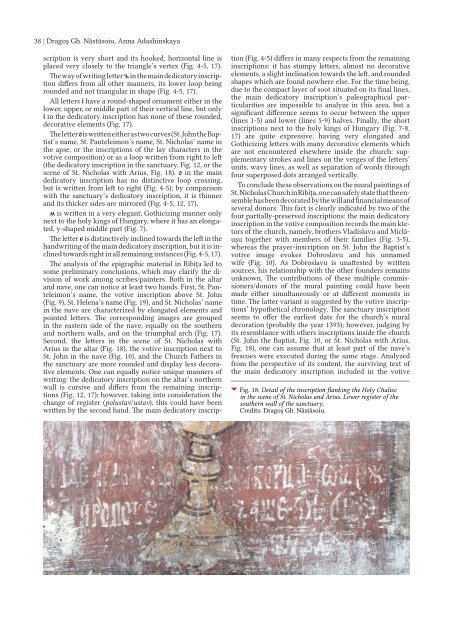Museikon_1_2017
You also want an ePaper? Increase the reach of your titles
YUMPU automatically turns print PDFs into web optimized ePapers that Google loves.
38 | Dragoş Gh. Năstăsoiu, Anna Adashinskaya<br />
scription is very short and its hooked, horizontal line is<br />
placed very closely to the triangle’s vertex (Fig. 4-5, 17).<br />
The way of writing letter ъ in the main dedicatory inscription<br />
differs from all other manners, its lower loop being<br />
rounded and not triangular in shape (Fig. 4-5, 17).<br />
All letters і have a round-shaped ornament either in the<br />
lower, upper, or middle part of their vertical line, but only<br />
і in the dedicatory inscription has none of these rounded,<br />
decorative elements (Fig. 17).<br />
The letter о is written either as two curves (St. John the Baptist’s<br />
name, St. Panteleimon’s name, St. Nicholas’ name in<br />
the apse, or the inscriptions of the lay characters in the<br />
votive composition) or as a loop written from right to left<br />
(the dedicatory inscription in the sanctuary, Fig. 12, or the<br />
scene of St. Nicholas with Arius, Fig. 18). о in the main<br />
dedicatory inscription has no distinctive loop crossing,<br />
but is written from left to right (Fig. 4-5); by comparison<br />
with the sanctuary’s dedicatory inscription, it is thinner<br />
and its thicker sides are mirrored (Fig. 4-5, 12, 17).<br />
м is written in a very elegant, Gothicizing manner only<br />
next to the holy kings of Hungary, where it has an elongated,<br />
y-shaped middle part (Fig. 7).<br />
The letter е is distinctively inclined towards the left in the<br />
handwriting of the main dedicatory inscription, but it is inclined<br />
towards right in all remaining instances (Fig. 4-5, 17).<br />
The analysis of the epigraphic material in Ribiţa led to<br />
some preliminary conclusions, which may clarify the division<br />
of work among scribes/painters. Both in the altar<br />
and nave, one can notice at least two hands. First, St. Panteleimon’s<br />
name, the votive inscription above St. John<br />
(Fig. 9), St. Helena’s name (Fig. 19), and St. Nicholas’ name<br />
in the nave are characterized by elongated elements and<br />
pointed letters. The corresponding images are grouped<br />
in the eastern side of the nave, equally on the southern<br />
and northern walls, and on the triumphal arch (Fig. 17).<br />
Second, the letters in the scene of St. Nicholas with<br />
Arius in the altar (Fig. 18), the votive inscription next to<br />
St. John in the nave (Fig. 10), and the Church Fathers in<br />
the sanctuary are more rounded and display less decorative<br />
elements. One can equally notice unique manners of<br />
writing: the dedicatory inscription on the altar’s northern<br />
wall is cursive and differs from the remaining inscriptions<br />
(Fig. 12, 17); however, taking into consideration the<br />
change of register (polustav/ustav), this could have been<br />
written by the second hand. The main dedicatory inscription<br />
(Fig. 4-5) differs in many respects from the remaining<br />
inscriptions: it has stumpy letters, almost no decorative<br />
elements, a slight inclination towards the left, and rounded<br />
shapes which are found nowhere else. For the time being,<br />
due to the compact layer of soot situated on its final lines,<br />
the main dedicatory inscription’s paleographical particularities<br />
are impossible to analyze in this area, but a<br />
significant difference seems to occur between the upper<br />
(lines 1-5) and lower (lines 5-9) halves. Finally, the short<br />
inscriptions next to the holy kings of Hungary (Fig. 7-8,<br />
17) are quite expressive, having very elongated and<br />
Gothicizing letters with many decorative elements which<br />
are not encountered elsewhere inside the church: supplementary<br />
strokes and lines on the verges of the letters’<br />
units, wavy lines, as well as separation of words through<br />
four superposed dots arranged vertically.<br />
To conclude these observations on the mural paintings of<br />
St. Nicholas Church in Ribiţa, one can safely state that the ensemble<br />
has been decorated by the will and financial means of<br />
several donors. This fact is clearly indicated by two of the<br />
four partially-preserved inscriptions: the main dedicatory<br />
inscription in the votive composition records the main ktetors<br />
of the church, namely, brothers Vladislavu and Miclăuşu<br />
together with members of their families (Fig. 3-5),<br />
whereas the prayer-inscription on St. John the Baptist’s<br />
votive image evokes Dobroslavu and his unnamed<br />
wife (Fig. 10). As Dobroslavu is unattested by written<br />
sources, his relationship with the other founders remains<br />
unknown. The contributions of these multiple commissioners/donors<br />
of the mural painting could have been<br />
made either simultaneously or at different moments in<br />
time. The latter variant is suggested by the votive inscriptions’<br />
hypothetical chronology. The sanctuary inscription<br />
seems to offer the earliest date for the church’s mural<br />
decoration (probably the year 1393); however, judging by<br />
its resemblance with others inscriptions inside the church<br />
(St. John the Baptist, Fig. 10, or St. Nicholas with Arius,<br />
Fig. 18), one can assume that at least part of the nave’s<br />
frescoes were executed during the same stage. Analyzed<br />
from the perspective of its content, the surviving text of<br />
the main dedicatory inscription included in the votive<br />
Fig. 18: Detail of the inscription flanking the Holy Chalice<br />
in the scene of St. Nicholas and Arius. Lower register of the<br />
southern wall of the sanctuary.<br />
Credits: Dragoş Gh. Năstăsoiu.


